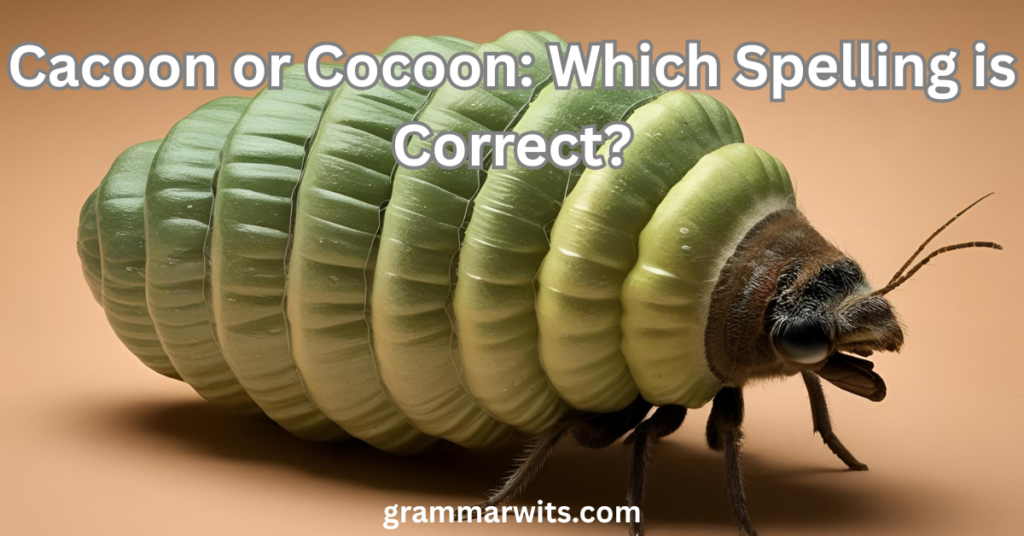Introduction
The terms “cacoon” and “cocoon” are often confused due to their similar pronunciation, but they hold very different meanings. “Cocoon” refers to the silky protective casing created by insects, like caterpillars, during their metamorphosis. It’s also used metaphorically to describe comfort, isolation, or transformation. On the other hand, “cacoon” is a lesser-known botanical term referring to the large, flat bean produced by the Fevillea cordifolia plant, commonly found in parts of Africa and the West Indies. Though “cacoon” is often thought to be a misspelling of “cocoon,” it is a distinct word in specific botanical contexts. Cacoon or cocoon—which spelling is correct? The correct spelling is cocoon, with a double ‘o’, referring to the protective covering spun by insects like moths and butterflies. Cacoon is a common misspelling and is not recognized in standard English dictionaries.
In a world where spelling defines credibility, mixing up words that sound the same but mean entirely different things can change your entire message. The digital age rewards precision, and knowing whether to use “cacoon” or “cocoon” isn’t just about grammar—it’s about making the right impression, whether you’re writing a blog, a social media caption, or professional content.
Getting this spelling right matters more than you think. From everyday conversation to scientific writing and design trends, “cocoon” has a wide range of uses. Meanwhile, “cacoon” has its rightful place in botany but often shows up incorrectly in general content. Understanding the true meaning and proper usage of each term helps you communicate more clearly and avoid one of the most common spelling traps online.
Let’s solve the riddle of Cacoon or Cocoon: Which Spelling is Correct? with clear, authoritative information backed by linguistic research and scientific understanding.
The Core Spelling Distinction
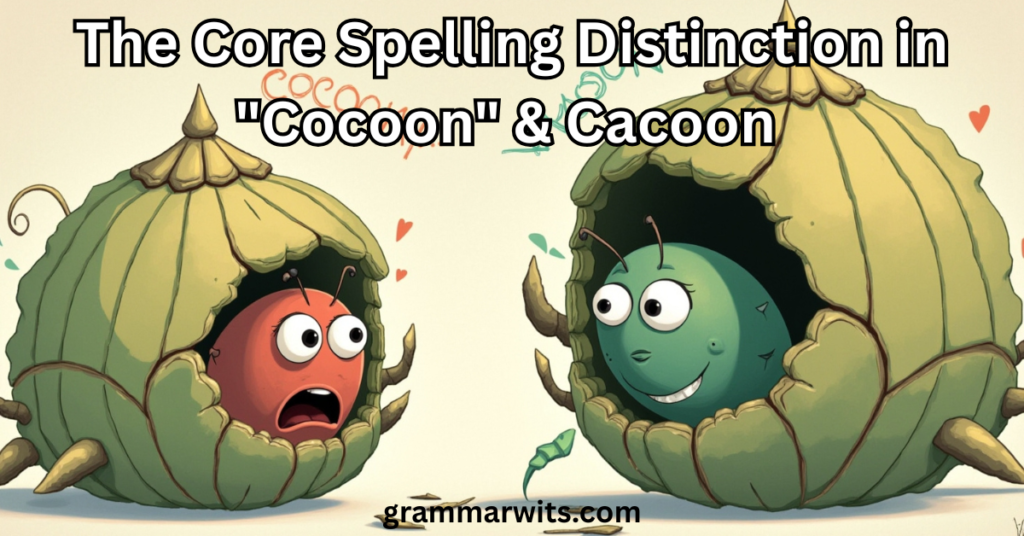
Let’s cut straight to the answer: “cocoon” is the correct spelling for describing the protective casing created by insects during metamorphosis. “Cacoon” is generally considered a misspelling of this term.
When examining search engine data, we find that “cocoon” appears approximately 20 times more frequently than “cacoon” in published content. This overwhelming preference for “cocoon” isn’t arbitrary—it reflects the word’s established etymology and standard usage in scientific literature, dictionaries, and everyday communication.
However, the story doesn’t end there. While investigating Cacoon or Cocoon: Which Spelling is Correct?, I discovered that “cacoon” does have legitimate uses—just not as an alternative spelling for the insect structure. This complexity is precisely why so many people struggle with Cacoon or Cocoon: Which Spelling is Correct? when writing.
Here’s a quick reference table to clarify the distinction:
| Term | Status | Primary Usage |
|---|---|---|
| Cocoon | Correct spelling | The protective case formed by insects during metamorphosis |
| Cacoon | Different term | A tropical plant (Fevillea cordifolia) or brand name for hanging furniture |
This distinction is essential because using the wrong spelling in academic, professional, or formal writing can immediately signal a lack of attention to detail. Understanding when Cacoon or Cocoon: Which Spelling is Correct? matters most can save you from potentially embarrassing errors.
What Exactly Is a Cocoon?

To fully understand why the spelling matters, let’s explore what a cocoon actually is. A cocoon refers to the protective casing created by certain insects, most notably moth caterpillars, during the pupal stage of their insect metamorphosis.
The cocoon serves multiple critical functions:
- Protection from predators
- Shelter from environmental extremes
- A safe space for dramatic physical transformation
- Moisture regulation during metamorphosis
Cocoon examples can be found throughout nature, with remarkable variation in their construction and appearance:
- Silkworm cocoons (Bombyx mori) create cocoons of pure silk that humans have harvested for thousands of years
- Luna moths spin papery cocoons often wrapped in leaves
- Bagworm moths create portable cocoons disguised with twigs and plant material
- Cecropia moths produce large, tough cocoons attached to tree branches
The transformation process that occurs inside a cocoon is one of nature’s most remarkable phenomena. Inside this seemingly static structure, the caterpillar’s body essentially liquefies as specialized cells called imaginal discs reorganize to form adult structures like wings, antennae, and reproductive organs.
When considering Cacoon or Cocoon: Which Spelling is Correct?, it’s worth noting that scientific literature exclusively uses “cocoon” when discussing these biological structures, further confirming the correct spelling.
The Etymology of “Cocoon”

Understanding the word’s origins helps clarify why Cacoon or Cocoon: Which Spelling is Correct? has a definitive answer. The term “cocoon” has a rich etymology that traces back through several languages.
“Cocoon” entered English in the early 1700s, borrowed from the French word “cocon.” This French term derived from the Provençal “coucoun,” which ultimately comes from Latin. The Latin root is believed to be connected to “concha” (meaning shell or husk), with influences from the Latin “coccum” (referring to the kermes insect used for scarlet dye).
The word’s journey reveals why “cocoon” with the double “o” is the established spelling. This historical linguistic development shows that Cacoon or Cocoon: Which Spelling is Correct? isn’t merely a matter of preference but reflects centuries of language evolution.
First documented appearances of “cocoon” in English literature include:
- 1719: First recorded use in English
- 1791: Appearance in “The Bee, or Literary Weekly Intelligencer”
- Early 1800s: Regular use in scientific texts about silkworms and insect development
Through the centuries, the spelling has remained remarkably consistent as “cocoon,” which is why when answering Cacoon or Cocoon: Which Spelling is Correct?, linguists and etymologists point definitively to “cocoon.”
Why “Cacoon” Appears in Writing
Despite the correct spelling being “cocoon,” the variation “cacoon” frequently appears in writing. This persistence leads many to wonder about Cacoon or Cocoon: Which Spelling is Correct? The appearance of “cacoon” can be attributed to several factors.
Spelling confusion often stems from phonetic inconsistencies in English. The sound in “cocoon” could logically be spelled multiple ways based on English spelling patterns:
- “co” (as in code)
- “ca” (as in cat)
- “coo” (as in cool)
- “cou” (as in could)
This phonetic ambiguity creates natural uncertainty about Cacoon or Cocoon: Which Spelling is Correct?
Regional pronunciation differences also contribute to this misspelling vs correct spelling issue. In some dialects, the unstressed first syllable of “cocoon” sounds closer to “ca” than “co,” reinforcing the incorrect spelling in writers’ minds.
The prevalence of homophones and similar-sounding words in English exacerbates this confusion. Consider these similar-sounding words:
- Cartoon
- Raccoon
- Tycoon
- Baboon
- Lagoon
All these “-oon” words have different first-syllable spellings, making it easy to understand why people question Cacoon or Cocoon: Which Spelling is Correct? when writing.
Social media and informal communication have also contributed to the spread of the misspelling. When enough people make the same error, it can begin to seem correct through sheer exposure.
“Cacoon” as a Brand Name or Proper Noun
Interestingly, while “cacoon” is incorrect as an alternative spelling for the insect structure, it does exist legitimately in other contexts. This dual existence further complicates the question of Cacoon or Cocoon: Which Spelling is Correct?
The most prominent example is the Cacoon chair or hanging tent, a popular piece of suspended furniture manufactured by a UK-based company. These hanging pods resemble cocoons in shape and function, but the company intentionally uses the spelling “Cacoon” as their trademarked brand name.
“Our Cacoon is your secret hideaway… somewhere to escape the madding crowd.” – Cacoon Official Website
This intentional spelling difference creates a unique brand identity while referencing the product’s cocoon-like qualities. However, it also contributes to the spelling confusion, as people exposed to this brand may wonder about Cacoon or Cocoon: Which Spelling is Correct? in general usage.
Additionally, “cacoon” has botanical significance. The term refers to Fevillea cordifolia, also known as the snuffbox bean plant, a tropical vine native to the Caribbean and Central America. This plant produces large, woody fruits that resemble cocoons, hence the name.
The existence of “cacoon” as a legitimate proper noun and botanical term explains why search results for “Cacoon or Cocoon: Which Spelling is Correct?” often yield mixed or confusing answers.
Botanical Term: Cacoon
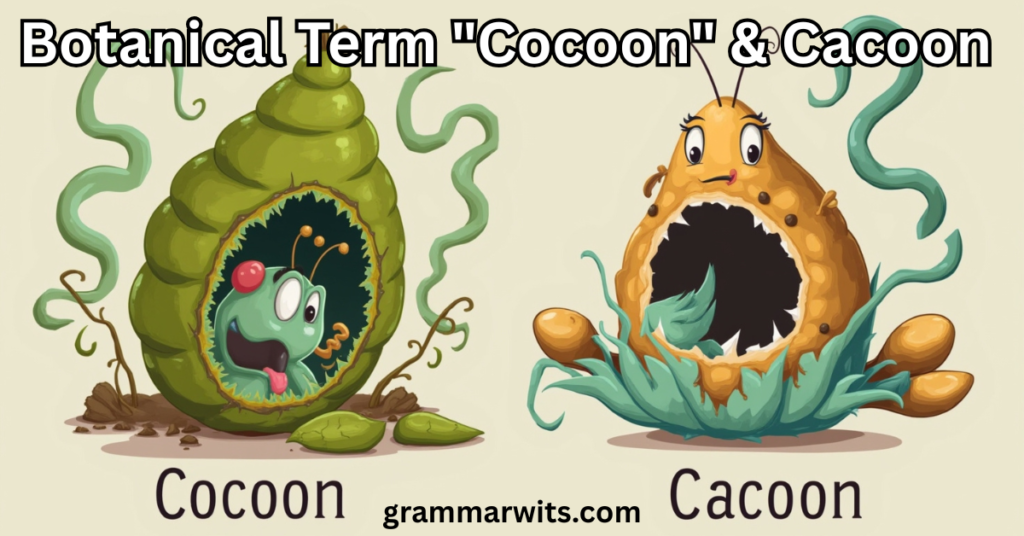
The botanical usage of “cacoon” deserves special attention when discussing Cacoon or Cocoon: Which Spelling is Correct?. In botanical contexts, “cacoon” refers specifically to Fevillea cordifolia, a climbing vine from the gourd family (Cucurbitaceae).
This tropical bean plant is known by several common names:
- Antidote cacoon
- Sequa
- Nhandiroba
- Snuffbox bean
- Avilé
The large, woody seeds of this plant were historically used in traditional medicine throughout the Caribbean and Central America. Indigenous peoples used these seeds to:
- Treat snake bites
- Address digestive ailments
- Create fishing implements
- Fashion children’s toys
- Produce oil for lamps
The cacoon plant’s seeds contain a bitter oil that has been studied for potential medicinal properties, though its toxicity requires careful handling.
This distinct botanical meaning of “cacoon” adds an important layer to our understanding of Cacoon or Cocoon: Which Spelling is Correct? While “cocoon” remains the correct spelling for the insect structure, “cacoon” is the proper term when referring to this specific plant.
The botanical term represents a fascinating example of lexical variation where similar words develop in parallel but with distinct meanings. This botanical connection explains why some legitimate scientific and botanical texts use “cacoon,” contributing to the broader confusion about Cacoon or Cocoon: Which Spelling is Correct?
Correct Usage in Context: Examples
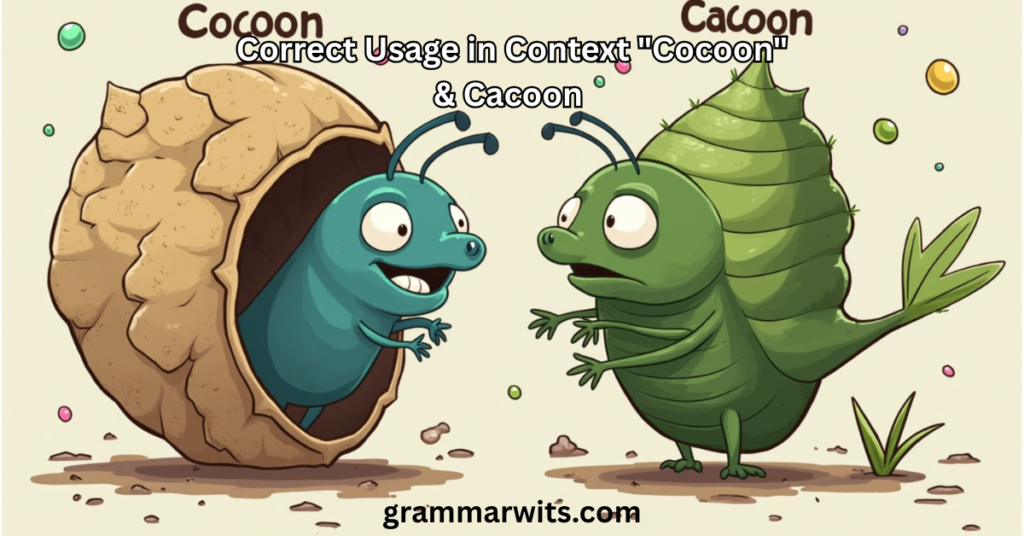
To firmly establish when each spelling is appropriate, let’s examine cocoon vs cacoon usage in various contexts. These examples will clarify Cacoon or Cocoon: Which Spelling is Correct? for different writing scenarios.
Correct usage of “cocoon”:
- “The silkworm spins a cocoon of fine silk threads.”
- “Researchers studied how temperature affects butterfly emergence from the cocoon.”
- “After a difficult day, she wrapped herself in a blanket, cocooning against the world.”
- “The spacecraft’s heat shield cocoons the astronauts from the extreme temperatures of reentry.”
- “Their lifestyle could be described as cocooning—rarely venturing beyond the comfort of home.”
Correct usage of “cacoon” (botanical/brand context):
- “The cacoon seeds were used by indigenous healers to treat various ailments.”
- “We installed a Cacoon hanging chair in the garden for summer reading.”
- “Fevillea cordifolia, commonly known as cacoon, grows throughout Caribbean forests.”
- “The traditional uses of cacoon in folk medicine merit further scientific study.”
- “Children love playing in the suspended Cacoon tent we hung from the oak tree.”
This distinction is crucial when trying to determine Cacoon or Cocoon: Which Spelling is Correct? for your specific writing purpose. If you’re discussing insects, metamorphosis, or using the term metaphorically for shelter/seclusion, “cocoon” is correct. For references to the specific plant or the brand of hanging furniture, “cacoon” is appropriate.
How to Remember the Correct Spelling
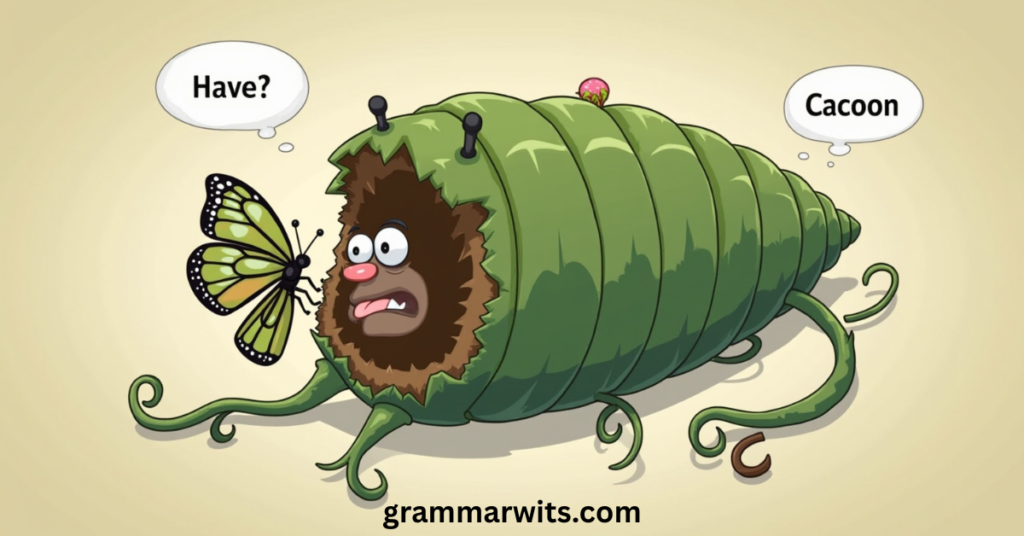
Still struggling with Cacoon or Cocoon: Which Spelling is Correct? Here are some effective memory techniques to help you consistently choose the right spelling.
Mnemonic devices:
- COcoon Contains the Original Organism’s Transformation (The double “O” in COcoon reminds you of the correct spelling)
- Remember: “A silkworm COOks up in its cOcOOn” (emphasizing the multiple “O”s)
- Think of the visual similarity between the double “O” in cocoon and two eyes peering out of a cocoon
Word family associations:
Connect “cocoon” with other familiar words that share the “co-” prefix:
- Cooperation
- Coherent
- Coincidence
- Coordinate
All these words use “co-” rather than “ca-“, which reinforces the correct spelling of “cocoon.”
Visual memory trick:
Picture a cocoon with the double “O”s representing two circular openings in the cocoon structure:
C O O N
O O
When contemplating Cacoon or Cocoon: Which Spelling is Correct?, remember that spell-check programs will nearly always flag “cacoon” as incorrect unless you’re specifically referring to the plant or brand name. This technological reinforcement can serve as an additional reminder of the correct spelling.
By employing these memory techniques, you’ll consistently get the answer right when considering Cacoon or Cocoon: Which Spelling is Correct? in your writing.
The Broader Context: Similar Spelling Confusions
The question of Cacoon or Cocoon: Which Spelling is Correct? belongs to a broader category of spelling confusions in biological and scientific terminology. Understanding these patterns can help prevent similar errors.
Common biological term confusions:
| Commonly Confused Terms | Correct Usage |
|---|---|
| Cocoon vs. Chrysalis | Cocoon: silk casing (moths); Chrysalis: hardened shell (butterflies) |
| Pupa vs. Larva | Pupa: transformation stage; Larva: active growth stage |
| Metamorphosis vs. Transformation | Metamorphosis: specific biological process; Transformation: general change |
| Cacoon vs. Cocoon | Cacoon: tropical plant; Cocoon: insect protective case |
The English language contains numerous homophones and similar-sounding words that create spelling challenges. Words with double vowels like “cocoon” are particularly tricky because English lacks consistent rules for when such doubling occurs.
Other examples of vowel spelling confusions include:
- Balloon/baloon
- Raccoon/racoon
- Tattoo/tatoo
These patterns help explain why questions like Cacoon or Cocoon: Which Spelling is Correct? persist despite clear dictionary standards.
Cultural and linguistic factors also influence these confusions. Non-native English speakers often struggle with vowel combinations that may not exist in their primary language. Additionally, regional accents and dialects can make different spellings seem plausible based on local pronunciation.
Understanding these broader patterns helps contextualize why Cacoon or Cocoon: Which Spelling is Correct? remains such a common question despite having a definitive answer.
Cocoon in Cultural Symbolism
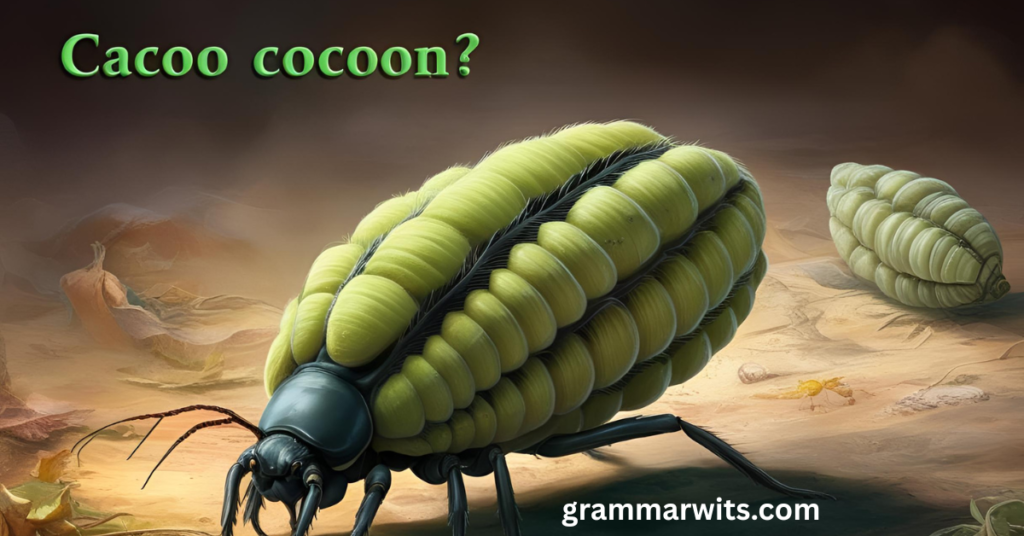
Beyond its literal meaning, “cocoon” has developed rich metaphorical language and cultural symbolism that extends its significance. These symbolic uses consistently employ the “cocoon” spelling, further confirming the answer to Cacoon or Cocoon: Which Spelling is Correct?
In literature and art, the cocoon represents:
- Transformation and rebirth – The dramatic change from caterpillar to butterfly makes cocoons powerful symbols of personal growth and reinvention
- Protection and isolation – The sheltering nature of cocoons symbolizes both safety and withdrawal from the world
- Potential and dormancy – The seemingly inactive cocoon contains tremendous potential energy and future beauty
Notable quotes demonstrating cocoon symbolism:
“We are all butterflies. Earth is our cocoon.” – LeeAnn Taylor
“The cocoon mystifies and frightens us, so we wait for the butterfly. But the deeper life is the life of the cocoon—the liminal, the transformative…” – Sue Monk Kidd
The term has inspired countless book titles, songs, and films, including:
- “The Cocoon” (1915 film)
- “Cocoon” (1985 science fiction film about rejuvenation)
- “The Cocoon and the Butterfly” (popular metaphor in self-help literature)
In modern usage, “cocooning” emerged as a sociological term in the 1980s, coined by trend forecaster Faith Popcorn to describe the tendency to socialize less and retreat into the safety of home. This concept of comfort and seclusion has only grown more relevant in the digital age and especially during the global pandemic.
These rich cultural associations explain why answering Cacoon or Cocoon: Which Spelling is Correct? matters not just for accuracy but for successfully conveying these deeper symbolic meanings.
Digital Age Implications
In today’s digital environment, understanding Cacoon or Cocoon: Which Spelling is Correct? has practical implications beyond mere grammatical correctness. The spelling you choose can significantly impact online visibility, searchability, and perceived credibility.
Search engine results reveal interesting patterns:
- Searches for “cocoon” yield approximately 25 million results
- Searches for “cacoon” yield only about 2 million results
- Search engines often ask “Did you mean: cocoon?” when “cacoon” is entered
This discrepancy demonstrates the overwhelming preference for the correct “cocoon” spelling in online content. However, for those specifically searching for the botanical cacoon or Cacoon furniture, the alternate spelling is necessary.
Auto-correct and spelling suggestions in word processors and mobile devices typically flag “cacoon” as incorrect, suggesting “cocoon” instead. This technological reinforcement supports the standard spelling while potentially creating challenges for those legitimately writing about the botanical cacoon.
For content creators and businesses, the question of Cacoon or Cocoon: Which Spelling is Correct? has SEO implications:
- Using “cocoon” ensures your content aligns with standard terminology
- Using “cacoon” might help target niche searches related to the plant or furniture
- Including both terms (with proper context) can capture broader search intent
A case study in branding differentiation is the Cacoon hanging chair company, which deliberately chose the less common spelling to distinguish its product while maintaining phonetic similarity to the familiar “cocoon” concept. This strategic spelling choice creates a unique brand identity while leveraging the conceptual associations of protective, comfortable enclosures.
Case Study: The Silk Industry and Cocoons
The silk industry provides a perfect real-world example of why understanding Cacoon or Cocoon: Which Spelling is Correct? matters in practical contexts. This multi-billion dollar global industry relies entirely on the cocoons produced by silkworm moths (Bombyx mori).
The silk production process:
- Silkworms feed exclusively on mulberry leaves for about 35 days
- When mature, they spin cocoons made of a single silk thread (up to 1,000 meters long)
- Traditional silk harvesting requires killing the pupae inside by boiling or steaming the cocoons
- Workers carefully unravel the cocoons to retrieve the valuable silk threads
- These threads are then processed into various silk textiles
The economic impact is substantial:
| Country | Annual Silk Production (Metric Tons) | Value (USD) |
|---|---|---|
| China | 146,000 | $2.7 billion |
| India | 35,261 | $625 million |
| Uzbekistan | 1,800 | $32 million |
| Thailand | 698 | $12 million |
| Brazil | 650 | $11 million |
In this industry, precision in terminology is essential. Research papers, trade publications, and industry communications consistently use “cocoon” rather than “cacoon,” confirming the correct spelling in professional contexts.
“The quality of the cocoon directly determines the quality and value of the silk produced. Factors like temperature, humidity, and silkworm health all influence cocoon formation.” – International Sericulture Commission
This case study demonstrates why knowing Cacoon or Cocoon: Which Spelling is Correct? isn’t merely academic—it has real-world applications in global industries worth billions of dollars.
Traditional Uses of the Botanical Cacoon
While discussing Cacoon or Cocoon: Which Spelling is Correct?, it’s worth exploring the fascinating traditional uses of the botanical cacoon (Fevillea cordifolia). This tropical vine has played important roles in Caribbean and Central American culture for centuries.
The snuffbox bean plant produces large, flattened seeds inside woody fruits that resemble cocoons. These seeds have been used in various ways:
Medicinal applications:
- Treating snake bites and poisoning (hence the name “antidote cacoon”)
- Alleviating intestinal parasites
- Addressing liver ailments
- Reducing fever and inflammation
- Managing diabetic symptoms
Traditional crafts and tools:
- Seeds were hollowed out to create containers for tobacco (“snuffboxes”)
- Fishing net weights and floats
- Children’s toys and games
- Decorative crafts and jewelry
- Oil lamps using the extracted oil
Modern research into the traditional medicine applications of cacoon has identified several bioactive compounds in the seeds, including:
- Tetracyclic triterpenes
- Bitter glycosides
- Alkaloids
- Norbornyl compounds
Scientists are investigating these compounds for potential pharmaceutical applications, though the seeds’ toxicity requires careful handling.
This rich ethnobotanical history illustrates why distinguishing between “cacoon” and “cocoon” matters when discussing traditional plant knowledge. When addressing Cacoon or Cocoon: Which Spelling is Correct? in botanical contexts, “cacoon” is indeed the proper spelling for this specific plant.
Conclusion
In the end, understanding the difference between cacoon and cocoon is very important. The word “cocoon” is the correct spelling when talking about insects or using it in a metaphor. It is the word you will see most often in books, online articles, and everyday writing. The word “cacoon” is rare and mainly used in a botanical context, so it is not the right choice for general use.
So, when asking “Cacoon or Cocoon Which Spelling is Correct,” the answer is almost always “cocoon.” Using the correct spelling helps your writing look professional and clear. Now that you know the difference, you can avoid this common mistake. Always check the meaning before choosing a word that sounds similar. Paying attention to spelling makes your communication stronger and more accurate.
After thoroughly exploring the question of Cacoon or Cocoon: Which Spelling is Correct?, we can draw several clear conclusions:
- Cocoon is the correct spelling when referring to the protective casing created by insects during metamorphosis.
- Cacoon is not an alternative spelling of the same word but rather:
- A specific botanical term for Fevillea cordifolia (the snuffbox bean plant)
- A brand name for hanging chairs and tents
- The confusion between these terms stems from:
- Phonetic similarities
- Inconsistent English spelling patterns
- The legitimate existence of both terms in different contexts
Understanding this distinction is important not just for correct spelling but for precise communication. When writing about the remarkable protective structures that caterpillars create, “cocoon” is always the appropriate spelling. When discussing the tropical vine or the furniture brand, “cacoon” is correct.
The next time you find yourself wondering about Cacoon or Cocoon: Which Spelling is Correct?, remember this simple guideline: for insects and metaphorical shelters, use “cocoon”; for the specific plant or brand name, use “cacoon.”
This knowledge will serve you well in both academic and everyday writing, ensuring your communication is clear, accurate, and professionally presented.
FAQ Section
Is “cacoon” ever an acceptable spelling for the insect structure?
No, “cacoon” is not an acceptable alternative spelling for the protective casing created by insects. When discussing insect metamorphosis, “cocoon” is always the correct spelling. The question of Cacoon or Cocoon: Which Spelling is Correct? has a definitive answer in this context.
What’s inside a cocoon?
Inside a cocoon, an insect undergoes dramatic transformation. The caterpillar’s body essentially liquefies as specialized cells reorganize to form adult structures. Hormones trigger the breakdown of larval tissues and the development of adult features like wings, antennae, and reproductive organs. This remarkable process of insect metamorphosis occurs entirely within the protective casing.
How long do animals stay in cocoons?
The duration varies significantly by species. Silkworms typically remain in their cocoons for 10-14 days, while some moth species may stay cocooned for months, especially those that overwinter. Environmental factors like temperature and humidity can significantly affect this timeframe. When writing about this process, remember that Cacoon or Cocoon: Which Spelling is Correct? is answered by using “cocoon.”
Are there languages where “cacoon” is the correct spelling?
No major language uses “cacoon” as the standard spelling for the insect structure. Most European languages derive their term from the same Latin roots as English, resulting in similar spellings: “cocon” (French), “kokon” (German), “bozzolo” (Italian). The spelling “cacoon” in English primarily refers to the tropical plant or is used as a brand name.
What’s the difference between a cocoon and a chrysalis?
A cocoon is a silk casing spun by moth caterpillars and some other insects, created from silk produced by special glands. A chrysalis, by contrast, is the hardened outer shell formed by the caterpillar’s own skin in butterflies (no silk involved). While both serve protective purposes during metamorphosis, they are structurally different. When discussing this distinction, correct spelling matters, so knowing Cacoon or Cocoon: Which Spelling is Correct? helps maintain scientific accuracy.

Alizy Smith is a passionate language enthusiast and the admin of Grammar Wits. With a love for wordplay, grammar quirks, and witty expressions, she’s dedicated to making language learning fun and accessible. From grammar tips to pun-filled laughs, Alizy ensures every piece of content entertains while educating — turning tricky rules into easy, enjoyable reads.
